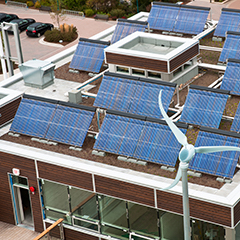Tax Breaks for Green Manufacturers
April 26, 2021 | Business Plans, Tax Planning
 In recent years, energy-efficient tax breaks have enticed many manufacturers to “go green.” At the end of 2020, The Consolidated Appropriations Act (CAA) was enacted, which includes various provisions that expand and improve certain green tax breaks. Here are five examples that could benefit your company.
In recent years, energy-efficient tax breaks have enticed many manufacturers to “go green.” At the end of 2020, The Consolidated Appropriations Act (CAA) was enacted, which includes various provisions that expand and improve certain green tax breaks. Here are five examples that could benefit your company.
1. Energy-Efficient Buildings
Under prior law, a taxpayer could claim a Section 179D deduction of up to $1.80 per square foot for buildings that save at least 50% of the heating and cooling energy. Partial deductions of up to $0.60 per square foot may be available for measures that affect the building envelope, lighting, or heating and cooling systems.
The CAA made this 179D deduction permanent, as it was scheduled to expire after 2020. The law also indexes the amount of the $1.80-per-square-foot deduction limit for inflation.
2. Production Tax Credit
Manufacturers may be in line for the production tax credit (PTC) based on the kilowatt per hour electricity generated at qualified facilities using renewable sources for the first 10 years of production.
The PTC was scheduled to expire after 2019, but it was extended for another year through 2021 for the following types of facilities: Wind, Closed-loop biomass, Open-loop biomass, Geothermal energy, Landfill gas, Trash, Hydropower, and Marine and hydrokinetic renewable energy.
Your facility may qualify for the PTC if construction begins prior to 2022.
3. Investment Tax Credit
The investment tax credit (ITC) is available for solar and other renewable energy projects.
The CAA revises the ITC phaseout schedule as follows: 26% for projects started in 2021 and 2022, 22% for projects started in 2023, and 10% for projects that start construction after 2023. A similar phase-out schedule applies to fiber-optic solar, qualified fuel cell, qualified small wind energy property, and qualified energy recovery property.
Under the CAA, a firm can’t claim the ITC for projects that start construction after 2023.
Manufacturers aren’t under the same level of pressure to begin construction in time to qualify for the ITC With these provisions currently in place. In a related provision, firms may continue to elect to take the ITC in lieu of the PTC if construction begins before 2022.
4. Offshore Wind Tax Credit
The CAA also extends the ITC for qualified offshore wind facilities that begin construction before 2026. Offshore wind facilities that begin construction from 2017 through 2025 aren’t subject to the usual phase-outs for this credit. Thus, the ITC for offshore wind projects remains at 50%.
IRS Notice 2021-05 provides guidance on these issues. Notably, it creates a 10-year safe-harbor rule for construction to begin.
5. Carbon Sequestration Tax Credit
The carbon sequestration tax credit is available for each metric ton of qualified carbon oxide captured at a plant that meets certain technical requirements. For projects placed in service after February 8, 2018, the credit is claimed over a 12-year period beginning in the year in which the carbon capture equipment is placed in service. The credit ranges from $10 to $50 per metric ton, depending on the date the equipment is placed in service and the processes for capturing the carbon oxide.
The CAA extends the beginning of the construction date for certain qualified facilities by two years — through 2025 — to qualify for a credit for sequestering qualified carbon oxide disposed of in secure geological storage.
CAA Authorizes New Spending Measures
In addition to extending the deduction for energy-efficient buildings and energy-related tax credits, the CAA authorizes several spending measures to promote renewable energy and reduce carbon emission while stimulating the economy. This includes:
Creating programs to support green technology and advance research and development,
Emphasizing research, development, demonstration, and commercial applications to improve technology and systems relating to waterpower, hydropower, marine energy, hydrothermal, hydroelectric, geothermal, wind energy, and solar energy,
Setting national goals for renewable energy on federal property and establishing a national office to improve coordination among federal agencies,
Prioritizing methods for significantly reducing greenhouse gas emissions and developing carbon removal and improving conversion, use, and storage of carbon dioxide produced from fossil fuels,
Providing a multifaceted program for research, development, and technology used to integrate blue hydrogen technology in the industrial power sector and accounting for carbon capture and storage, and
Establishing a program to test, validate and improve technology and methodology for large-scale removal of carbon dioxide from the atmosphere.
Finally, the CAA addresses the need for programs to provide technical assistance for reducing industrial emissions. It also calls for an innovation advisory committee to develop strategies for improving productivity and energy efficiency in the manufacturing sector and other industries.
Go Green, Save Green
This is only a summary of five key tax breaks enhanced by the CAA. The Biden administration has indicated support for additional green initiatives, which may translate into more tax breaks for businesses. Please contact your professional advisors concerning your company’s efforts to become more energy efficient.
